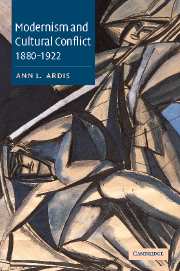Book contents
- Frontmatter
- Contents
- Acknowledgments
- Introduction: rethinking modernism, remapping the turn of the twentieth century
- 1 Beatrice Webb and the “serious” artist
- 2 Inventing literary tradition, ghosting Oscar Wilde and the Victorian fin de siècle
- 3 The Lost Girl, Tarr, and the “moment” of modernism
- 4 Mapping the middlebrow in Edwardian England
- 5 “Life is not composed of watertight compartments”: the New Age's critique of modernist literary specialization
- Conclusion: modernism and English studies in history
- Select bibliography
- Index
3 - The Lost Girl, Tarr, and the “moment” of modernism
Published online by Cambridge University Press: 22 September 2009
- Frontmatter
- Contents
- Acknowledgments
- Introduction: rethinking modernism, remapping the turn of the twentieth century
- 1 Beatrice Webb and the “serious” artist
- 2 Inventing literary tradition, ghosting Oscar Wilde and the Victorian fin de siècle
- 3 The Lost Girl, Tarr, and the “moment” of modernism
- 4 Mapping the middlebrow in Edwardian England
- 5 “Life is not composed of watertight compartments”: the New Age's critique of modernist literary specialization
- Conclusion: modernism and English studies in history
- Select bibliography
- Index
Summary
After Modernism is canonized … by the post-war settlements and its accompanying, complicit academic endorsements, there is then the presumption that since Modernism is here in this specific phase or period, there is nothing beyond it. The marginal or rejected artists become classics of organized teaching and of travelling exhibitions in the great galleries of the metropolitan cities. “Modernism” is confined to this highly selective field and denied to everything else in an act of pure ideology.
Raymond Williams, The Politics of Modernism[T]he moment of modernism is the moment of its construction as a rigorously exclusionary category of value in the twentieth-century academy, as the canonical form of early twentieth-century literature; a moment in which one particular form of aesthetic practice, a practice committed to particular kinds of formal and linguistic experimentation, was privileged above others; a moment in which a restricted group of texts and authors was removed from the complex social and cultural specificities of history and located in that transcendent ideal order of the literary tradition described (or invented) by Eliot in ‘Tradition and the Individual Talent’; a moment in which a particular ‘discipline of reading’ was established by the ‘intellectual hegemony of Eliot, Leavis, Richards, and the New Critics.’ In this latter sense, the moment of modernism is a prolonged one in which a hegemonic view of literary history and value is first produced and then reproduced by a literary academy committed to working constantly over the same relatively small group of texts.
Lyn Pykett, Engendering Fictions: The English Novel in the Twentieth Century- Type
- Chapter
- Information
- Modernism and Cultural Conflict, 1880–1922 , pp. 78 - 113Publisher: Cambridge University PressPrint publication year: 2002



